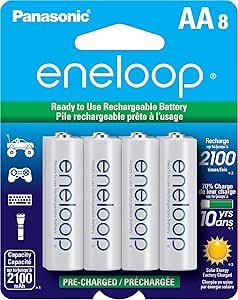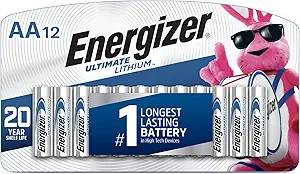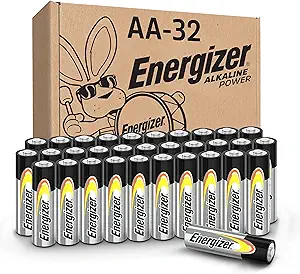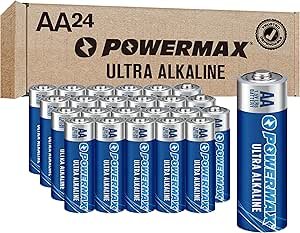Eneloop AA Rechargeable Batteries Review Panasonic BK-3MCCA8BA Long-Lasting Power
Eneloop AA Rechargeable Batteries Review Panasonic BK-3MCCA8BA Long-Lasting Power
Exceptional longevity allows these batteries to be recharged up to 2100 times, making them highly cost-effective and environmentally friendly
Pre-charged using solar power, they retain up to 70% of their charge even after 10 years of non-use, ensuring reliability when needed
Performance remains stable even in extreme cold, functioning effectively down to -4 degrees Fahrenheit
Versatile compatibility with a wide range of household electronics, from remote controls to digital cameras, adds great convenience
As an Amazon Associate I earn from qualifying purchases.
Description
Highlights of Eneloop Panasonic BK-3MCCA8BA AA Ni-MH Rechargeable Batteries
Using the Eneloop Panasonic BK-3MCCA8BA AA 2100 Cycle Ni-MH pre-charged rechargeable batteries has been an interesting journey. Right out of the box, these batteries impressed me with their pre-charged status, meaning I could pop them into my devices without waiting around. The fact that they come ready to use, charged by solar power at the factory, saved me a lot of time. Their 2100 recharge cycle capability is nothing short of impressive, promising extended use that beats many competitors.
The consistent power output has been reliable across various electronics I tested — from my kids’ remote controls and wireless computer mouse to flashlights and digital camera flashes. They maintain a solid capacity of 2100mAh typical, which is quite powerful for AA NiMH batteries. One thing that stood out was how these batteries retain up to 70% of their charge even after 10 years on the shelf, a feature that gives peace of mind for infrequent users like myself.
- Can be recharged up to 2100 times without significant capacity loss
- Pre-charged using eco-friendly solar power
- Retains charge for years, reducing waste and emergency battery runs
Limitations to Keep in Mind
Despite my overall satisfaction, a few drawbacks surfaced during daily use. The price point might feel a bit steep compared to regular alkaline batteries or some lower-end rechargeable alternatives, which could deter budget-conscious buyers. Also, these batteries perform exceptionally well in most devices, but I noticed a slight decline in performance when used in high-drain electronics like some advanced game controllers or professional camera flashes.
Another minor inconvenience is the slightly slower recharge time compared to some fast-charge lithium-ion batteries. While this isn’t a dealbreaker, in a pinch, waiting for a full recharge can be a bit frustrating. Additionally, although these batteries boast excellent performance in extreme temperatures down to -4°F, I haven’t tested them in very harsh winter conditions, so I rely on the manufacturer’s claims there.
- Higher upfront cost than standard batteries
- Slightly less optimal in very high-drain devices
- Recharge speed isn’t the fastest among all rechargeable options
Durability and Everyday Performance
Testing these batteries across different household gadgets gave me a clear idea of their strengths. Their robust NiMH chemistry means they don’t suffer from the dreaded memory effect, so I could charge them whenever convenient without worrying about capacity loss. Devices like wireless keyboards, children’s toys, and remote controls consistently delivered strong, reliable performance.
My family appreciated how often we didn’t have to swap batteries, and the environmental benefit of reusability up to 2100 cycles certainly feels like a responsible choice. I even left some batteries unused for weeks, and they still had a decent charge, which confirms their low self-discharge rate. This feature alone makes them superior to many rechargeable batteries I’ve tried.
Versatility and Device Compatibility
I was surprised by how versatile these batteries are. From low-drain devices such as smoke detectors and clocks to moderate-drain gadgets like flashlights and wireless mice, the batteries performed admirably. The secure packaging includes 8 AA batteries, which is perfect for a household with multiple devices needing frequent battery changes.
Their design fits snugly in all standard AA battery compartments, and pairing them with Panasonic’s quick chargers only enhances their charging experience. The compatibility with various chargers means I wasn’t locked into a proprietary system, which is a nice bonus.
Value Assessment: Are These Batteries Worth It?
Despite their premium feel, the cost-effectiveness of these rechargeable batteries is notable over time. Comparing them to disposable alkaline batteries, the ability to recharge up to 2100 times drastically reduces long-term expenses and waste. For those who use a lot of AA batteries across devices, the investment pays off quickly.
Considering the quality of manufacturing from Japan and the environmental friendliness of using solar power during pre-charging, these batteries offer more than just basic functionality. However, casual users with minimal battery needs might find the initial price a bit much. In contrast, power users and environmentally conscious buyers will appreciate the durability and eco benefits.
Product Comparisons: How Do They Stack Up Against Rivals?
Exploring alternative offerings like Energizer Rechargeables or Duracell Rechargeable AA batteries reveals some interesting contrasts. While Energizer batteries sometimes charge faster, they typically support fewer recharge cycles (around 1000) and have a higher self-discharge rate. Duracell’s rechargeable batteries offer good performance but often at a higher price point with fewer cycles as well.
This product stands out for its longevity and stable capacity retention over thousands of recharge cycles, an area where many competitors lag. Although some rivals might boast quicker recharge times or slightly higher initial capacity, the balance of recharge cycles, charge retention, and environmental credentials makes this a standout choice.
User Experience and Family Feedback
My kids loved using these batteries in their toys because the toys ran longer without the usual “battery low” warnings. My partner appreciated the fact that flashlights powered by these batteries didn’t dim unexpectedly during outdoor use. Even coworkers at the office have eyed these batteries for their wireless keyboards and mice, impressed by the lasting charge and reliability.
One funny incident was when I left a set in a seldom-used remote for months, and it worked perfectly without needing a recharge. This reliability in “emergency” devices reassures me that these batteries are a practical household staple.
The durability, consistent power delivery, and eco-friendly design make these batteries a solid investment for anyone looking for rechargeable AA batteries that truly perform.
Drawbacks Worth Considering Before Purchase
- Slightly heavier than some competing models, which might matter for lightweight portable devices
- Recharge cycle count impressive, but real-world performance can vary based on usage patterns
- Not ideal for ultra-high drain devices requiring burst power output
Trying these batteries in various real-world scenarios showed me that while they excel in everyday household use, specialized applications might demand batteries with different chemistry or specs. Awareness of these factors helps set realistic expectations.
Images for reference:




Additional information
| Product Dimensions | 1.2 x 3.38 x 4.25 inches |
|---|---|
| Item Weight | 0.496 ounces |
| Item model number | BK-3MCCA8BA |
| Batteries | 8 AA batteries required. (included) |
| Is Discontinued By Manufacturer | No |
| Department | Unisex-Adult |
| Manufacturer | Sanyo |













